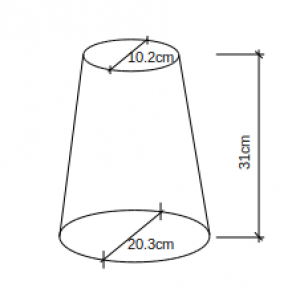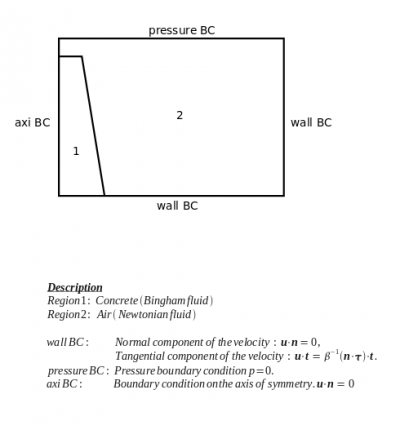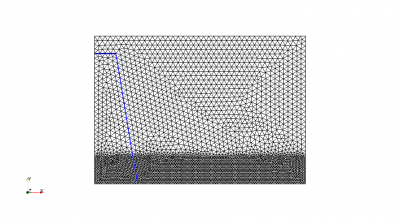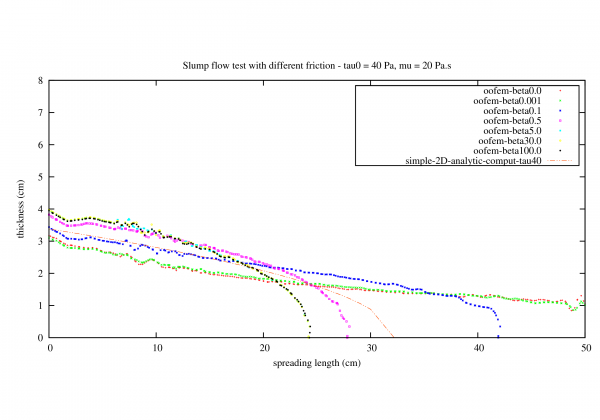Table of Contents
Slump flow test
Test setup and Geometry
This test is a typical test used to check consistency of a fresh concrete suspension, often used in laboratories and on site. The mould called slump cone is filled with concrete and then is lifted up by hand. Conrete slumps down due to gravity forces. Typically, the residual height and spreading diameter are recorded. In the presented example, the geometry of Abrams cone has been choosen (see the Fig. 1 for dimensions).
Computational Model
Due to the rotational symmetry, the problem is modeled in axisymmetric setting. The setup of computational domain, together with the description of boundary conditions and used materials is illustrated on Fig. 2. The whole problem is modeled as a two-phase flow problem, considering fresh concrete and air as the two immiscible phases. The mutual interface between the twofluids is tracked using the Level Set Method [2]. The air phase is modeled as a newtonian fluid, the fresh concrete suspension as non-Newtonian, Bingham fluid, with following parameters:
- density 2300 kg/m3,
- yield stress 40 Pa,
- viscosity 20 Pa.s.
The simulations were performed with different type of friction conditions assumed on horizontal plate. The full slip as well as different friction coefficients have been considered. The friction coefficient has been set to 0.0, 0.01, 0.1 and 5.0. A significant difference in flow patterns for different friction coefficient can be observed.
The computational mesh is shown on the Figure 3. It has been refined near the botom surface to improve accuracy of the boundary layer prediction as well as improved interface capturing. The triangular elements with eqaul order interpolation of velocity and pressure fields have been used. Since that element is not satisfying LBB condition, PSPG stabilization is used for preventing oscilations in pressure field. SUPG stabilization improving accuracy in connection with non-linear convective term is also used. For further information, see [3].
The example of OOFEM input file is available here: slump_beta0.01_tau40.0_mu20.0_oofem.in, desription of input parameters can be found here: Input File Description
Results
On the next four videos, the influence of boundary condition on the flow is illustrated. The Different values of friction coefficient were assumed (equal to 0, 0.01, 0.1 and 5.). Parameters of the Bingham model for concrete were following: yeld stress 40 [Pa], plastic viscosity 20 [Pa.s], and density 2300 [kg/m3].
| http://www.oofem.org/wiki/lib/exe/fetch.php | http://www.oofem.org/wiki/lib/exe/fetch.php |
| Friction coefficient 0.0 | Friction coefficient 0.01 |
| http://www.oofem.org/wiki/lib/exe/fetch.php | http://www.oofem.org/wiki/lib/exe/fetch.php |
| Friction coefficient 0.1 | Friction coefficient 5.0 |
On the next figure, the overall influence of friction is illustrated. Final spreading shape of SCC is plotted for different values of friction coefficient. Comparison with analytical solution of simplified problem is made (for further reference, see: [1])
References
[1] ROUSSEL N COUSSOT P, “Fifty-cent rheometer” for yield stress measurements : from slump to spreading flow, Journal of Rheology, 49(3) (2005) 705-718.)
[2] BARTH, T.; SETHIAN, J.A. (2009), Numerical Schemes for the HamiltonJacobi and Level Set Equations on Triangu- lated Domains. Journal of computational physics, 145 1-40.
[3] TEZDUYAR, T : Stabilized Finite Element Formulations for Incompressible Flow Computations, Advances in Applied Mechanics, Volume 28, 1991, Pages 1-44



